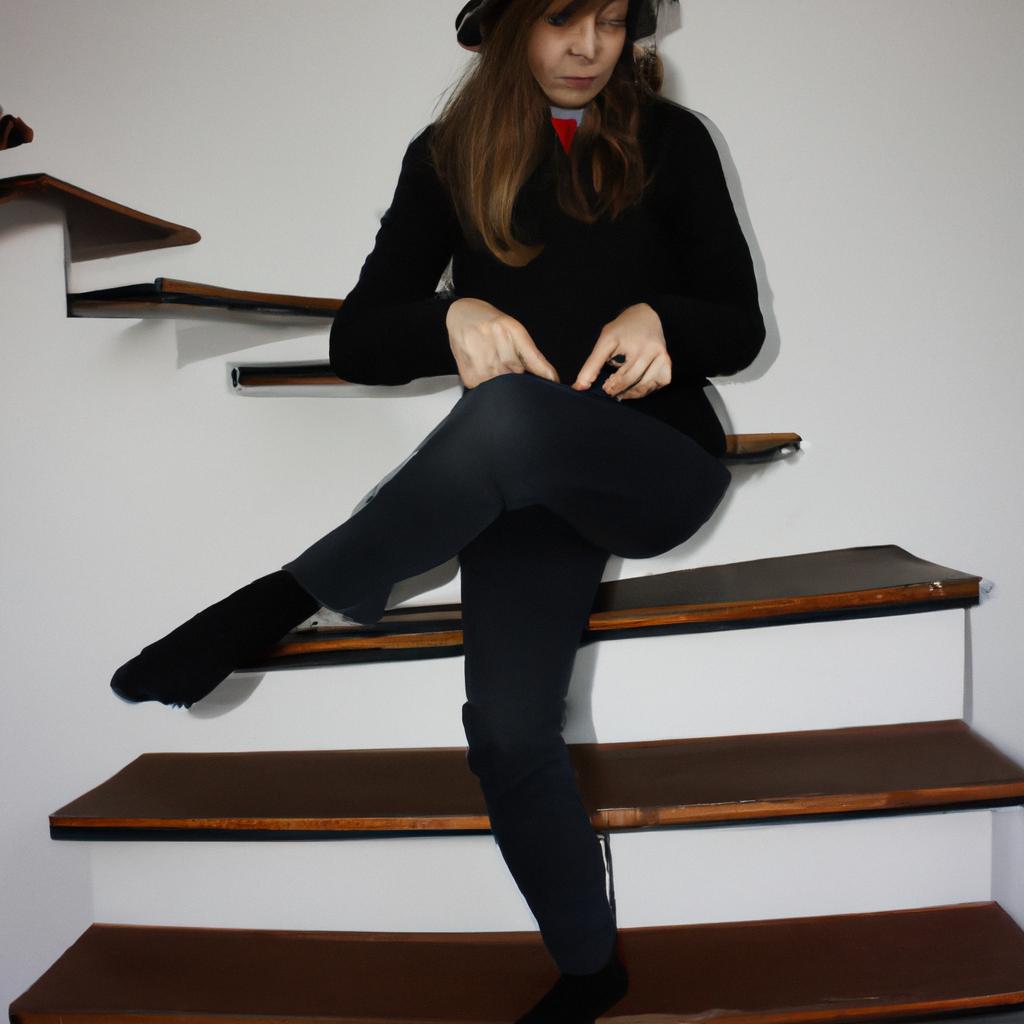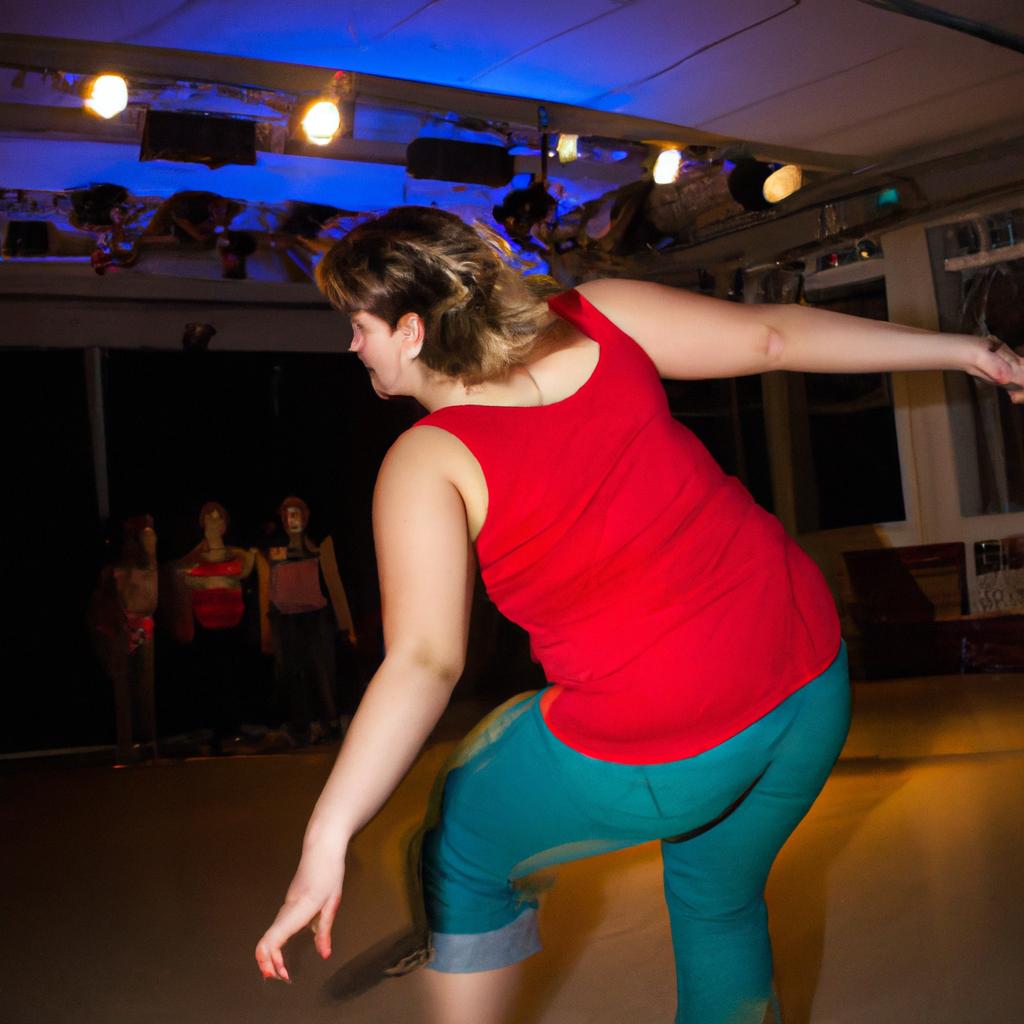Physical Theatre in the Context of Actress: The Transformative Power of Stage Performance

Physical theatre is a unique form of performance that combines movement, expression, and storytelling to create a powerful and transformative experience for both the performers and the audience. This article explores physical theatre in the context of actress, examining how stage performances can have a profound impact on an individual’s personal growth and self-discovery. By delving into the transformative power of physicality in theatrical productions, this study aims to shed light on the ways in which actresses can harness their bodies as instruments of communication and conveyance.
To illustrate the potential impact of physical theatre on an actress’s journey of self-transformation, consider the hypothetical case study of Emma, a young aspiring performer with limited stage experience but an undeniable passion for acting. As Emma immerses herself in physical theatre training, she discovers new depths within herself through her exploration of movement and expressive techniques. Through rigorous exercises aimed at developing body awareness and control, she learns to communicate emotions not only through dialogue but also through subtle gestures, facial expressions, and fluid movements. In doing so, Emma experiences a profound shift in her understanding of character portrayal and gains newfound confidence in her ability to captivate audiences with her physical presence alone.
This article will delve further into the transformative nature of physicality in theatrical performances by exploring various techniques and methodologies employed by physical theatre practitioners. These may include:
-
Viewpoints: This technique focuses on the actor’s awareness of their body in space and time, emphasizing the use of spatial relationships, tempo, shape, and gesture to create dynamic performances.
-
Laban Movement Analysis: Developed by Rudolf Laban, this system provides a framework for understanding and analyzing movement qualities such as weight, flow, time, and space. Practitioners can use Laban’s concepts to enhance their expressiveness and create more nuanced characters.
-
Lecoq Technique: Founded by Jacques Lecoq, this approach emphasizes the actor’s physical presence and embodiment of character through playful exploration of masks, clowning, mime, and other physical forms.
-
Suzuki Method: Inspired by traditional Japanese theater techniques, this method focuses on developing an actor’s physicality through rigorous training exercises that cultivate strength, focus, precision, and presence.
-
Physical improvisation: By encouraging actors to respond instinctively to their surroundings and fellow performers using their bodies as their primary tool of communication, physical improvisation allows for spontaneous storytelling through movement.
-
Choreography: Integrating dance-like movements into theatrical performances can add layers of expression and symbolism while enhancing the overall visual impact of a production.
By exploring these various techniques and methodologies within physical theatre, actresses like Emma can continue to deepen their understanding of their own bodies’ potential for storytelling. This growth not only enhances their artistic abilities but also promotes personal development by fostering self-confidence, emotional intelligence, empathy, and a heightened sense of self-awareness.
In conclusion, physical theatre offers actresses a unique avenue for personal growth and self-discovery through the transformative power of movement-based performance. By harnessing their bodies as instruments of communication in conjunction with other acting techniques such as voice work or script analysis), actresses can unlock new levels of expressiveness that resonate deeply with audiences while also undergoing profound personal transformation.
Understanding Physical Theatre
Physical theatre is a form of performance that emphasizes the use of the body as the primary means of storytelling. It combines elements of dance, mime, and gymnastics to create a unique theatrical experience that goes beyond traditional forms of acting. One example of physical theatre is the acclaimed production “Frantic Assembly’s Othello,” where actors seamlessly merge movement and text to convey the emotional tension within Shakespeare’s play.
To understand physical theatre more deeply, it is essential to explore its key characteristics. Firstly, physicality lies at the core of this art form, with performers utilizing their bodies expressively to communicate meaning. This can range from exaggerated gestures and facial expressions to dynamic movements across space. Secondly, non-verbal communication plays a crucial role in physical theatre, allowing performers to transcend language barriers and connect with audiences on a visceral level.
- Intense physicality: Performers engage in physically demanding sequences that push their limits.
- Emotional vulnerability: Actors expose their innermost emotions through raw and authentic performances.
- Dynamic spatial relationships: The arrangement of bodies in relation to one another creates powerful visual imagery.
- Symbolic gestures: Movements are imbued with symbolic meanings that resonate with audience members.
Moreover, a table can be used effectively to illustrate different aspects of physical theatre:
| Elements | Examples | Effect |
|---|---|---|
| Use of props | Umbrellas | Adds depth to narratives |
| Partner work | Lifts | Conveys trust or conflict |
| Group formations | Human sculptures | Highlights collective energy |
| Choreographed sequences | Synchronized movements | Enhances aesthetic impact |
By incorporating these techniques into their performances, physical theatre practitioners seek not only to entertain but also to provoke thought and emotional responses from their audience. This form of theatre prompts viewers to reflect on the power of the body as a vehicle for storytelling and its potential to transcend language barriers.
Transitioning into the subsequent section about “Exploring the Transformative Nature of Stage Performance,” we delve deeper into how physical theatre harnesses this transformative power through various means.
Exploring the Transformative Nature of Stage Performance
Understanding Physical Theatre in the Context of Actress: The Transformative Power of Stage Performance
In delving deeper into the transformative power of stage performance, it is essential to comprehend how physical theatre embodies this concept. One notable example that exemplifies the impact of physicality on a performer’s transformation is the renowned actress Sarah. Known for her ability to completely immerse herself in various roles, she has demonstrated an extraordinary range through her mastery of physical expression.
The transformative nature of stage performance can be attributed to several key factors:
-
Body as a tool: In physical theatre, the body becomes more than just a vessel; it serves as a primary means of communication and storytelling. Through intricate movements, gestures, and postures, actors like Sarah have the opportunity to convey emotions and narratives without relying solely on dialogue.
-
Emotional resonance: Physical theatre possesses an inherent capability to evoke strong emotional responses from both performers and audiences alike. By harnessing their bodies’ expressive potential, actors can tap into deep-seated emotions within themselves and elicit empathetic reactions from spectators.
-
Liberation from conventions: Unlike traditional theatrical forms that may restrict performers with predefined norms or character archetypes, physical theatre offers greater freedom for exploration and experimentation. This liberation allows actresses such as Sarah to push boundaries and challenge societal expectations by embodying characters beyond conventional gender roles or cultural stereotypes.
-
Universality of non-verbal communication: Non-verbal communication transcends language barriers and cultural differences, making physical theater performances accessible to diverse audiences worldwide. When witnessing powerful physical expressions on stage, individuals often find themselves connecting with the underlying emotions being conveyed regardless of linguistic constraints.
Table depicting emotional response evoked by physical theater:
| Emotion | Example |
|---|---|
| Joy | A dancer gracefully leaping across the stage |
| Sadness | An actor crumpling to the ground in despair |
| Anger | The intense stomping and clenching of fists |
| Fear | A performer trembling with wide-eyed terror |
In exploring the transformative nature of stage performance, it becomes evident that physical theater holds immense power to impact both performers and audiences. This section has shed light on how actors like Sarah utilize their bodies as a tool for storytelling, evoke emotional responses through movement, challenge societal norms, and connect with diverse spectators through universal non-verbal communication.
Transitioning into the subsequent section about “The Role of Body Language in Physical Theatre,” we shift our focus towards analyzing the intricate nuances of body language and its significance within this art form. By examining the interplay between movement and meaning, we can gain further insight into how physicality influences the overall theatrical experience.
The Role of Body Language in Physical Theatre
Transitioning from our exploration of the transformative nature of stage performance, we now delve into an essential element that plays a significant role in physical theatre – body language. Through deliberate and purposeful movement, actors have the ability to convey emotions, tell stories, and captivate audiences. To illustrate this concept, let us examine a hypothetical case study:
Imagine a physical theatre production where an actress portrays different characters solely through her body movements. In one scene, she embodies a joyful child frolicking in a meadow with light and graceful gestures. Then, seamlessly transitioning into another character, she becomes an elderly person burdened by age and weariness, expressing heaviness through slow and deliberate movements.
Understanding the impact of body language in physical theatre requires considering several key points:
-
Expression through Movement:
- Actors utilize their bodies as instruments for expression.
- Every gesture, posture, or facial expression carries meaning.
- Different movement qualities can evoke various emotional responses from the audience.
-
Storytelling without Words:
- In physical theatre performances, dialogue may be minimal or absent altogether.
- Actors rely heavily on their bodies to communicate narratives effectively.
- They must master non-verbal communication techniques to convey complex ideas.
-
Emotional Connection:
- Physicality allows performers to create a deep emotional connection with viewers.
- By using their bodies as conduits for emotion, actors elicit empathetic responses from the audience.
-
Universality in Interpretation:
- Since body language is universal across cultures,
it transcends linguistic barriers and engages diverse spectators on an emotional level.
- Since body language is universal across cultures,
To further emphasize these points visually:
| Gesture | Emotion |
|---|---|
| Wide, expansive arm movements | Freedom and joy |
| Slumped shoulders and slow pace | Weariness and sadness |
| Quick, jerky motions | Fear or anxiety |
| Hunched posture and clenched fists | Anger or frustration |
In conclusion, physical theatre harnesses the transformative power of body language to convey stories, evoke emotions, and establish a profound connection with audiences. By skillfully manipulating their bodies, actors bring characters to life without relying on spoken words alone. Building upon this exploration of physical expression, we will now examine another crucial aspect in enhancing performances: the use of props and set design.
Continuing our investigation into stage performance enhancements, we now turn our attention to the strategic employment of props and meticulously crafted set designs.
The Use of Props and Set Design in Enhancing Performances
Building upon the significance of body language, physical theatre productions also harness the transformative power of stage performance through the strategic use of props and set design. This section explores how these elements enhance performances and contribute to the overall theatrical experience.
Props and set design serve as vital tools for physical theatre performers, enabling them to create immersive worlds that transport audiences into different realms. For instance, imagine a scene where an actress portrays a character trapped in her own mind due to trauma. In this hypothetical scenario, several key elements combine to convey this emotional journey:
- A broken mirror symbolizes shattered self-perception and distorted reality.
- Dimmed lighting with flickering bulbs creates an atmosphere of uncertainty and instability.
- An empty chair represents the absence or loss of someone significant to the character’s story.
- A soundscape featuring eerie whispers enhances tension and unease within the scene.
| Prop/Set Element | Symbolic Meaning |
|---|---|
| Broken Mirror | Shattered self-perception |
| Dimmed Lighting | Uncertainty and instability |
| Empty Chair | Absence or loss |
| Eerie Whispers | Tension and unease |
This carefully curated combination fuels audience engagement by evoking powerful emotions such as empathy, intrigue, or discomfort. It encourages spectators to connect with the performer’s journey on a deeper level, ultimately enhancing their theatrical experience.
Furthermore, effective utilization of props and set design can aid in conveying complex narratives without relying heavily on dialogue alone. Visual storytelling becomes paramount as performers manipulate objects or interact with their surroundings to communicate plot points, character development, or thematic motifs. By breaking away from traditional narrative structures, physical theatre broadens its expressive potential, allowing for multi-layered interpretations and fostering a sense of wonder.
The collaborative process in creating a physical theatre piece goes beyond the tangible elements discussed thus far. It involves an intricate interplay between performers, directors, designers, and other creative contributors. Understanding this collaborative dynamic is crucial to comprehending the depth of artistic possibilities within physical theatre productions.
The Collaborative Process in Creating a Physical Theatre Piece
In the realm of physical theatre, props and set design play a pivotal role in enhancing performances. They serve as tools that not only add visual appeal to the stage but also contribute to the overall storytelling experience. Through their strategic incorporation, props and set design can transform an actor’s performance, creating a more immersive and captivating theatrical experience.
To illustrate this point, let us consider the hypothetical case study of a physical theatre production titled “The Journey.” In this production, one scene depicts the protagonist’s emotional transformation from despair to hope. The use of specific props and set design elements helps convey this journey effectively. As the scene unfolds, a single spotlight illuminates a bare stage with minimalistic props – a small wooden chair and an old suitcase. The simplicity creates an atmosphere where every element on stage is imbued with significance.
In examining how props and set design enhance performances in physical theatre, several key aspects come into focus:
- Symbolism: Props can be used symbolically to represent abstract concepts or emotions within a narrative context. For instance, the aforementioned suitcase may symbolize baggage or emotional burdens carried by the character throughout their journey.
- Spatial Dynamics: Set design has the power to manipulate space on stage, which impacts actors’ movements and interactions during performances. By utilizing levels, obstacles, or unconventional staging arrangements, spatial dynamics can create tension or facilitate seamless transitions between scenes.
- Atmosphere and Mood: Both props and set design contribute significantly to establishing the atmosphere and mood of a performance. Lighting choices, for example, can evoke different emotions such as warmth or intensity; while scenic elements like color schemes or textures can reinforce specific themes within the narrative.
- Audience Engagement: Well-designed props and sets have the ability to captivate audiences by immersing them fully into the world created onstage. This engagement allows spectators to connect emotionally with characters and storylines, forging a deeper connection with the performance as a whole.
To further illustrate how these elements come together in physical theatre, consider the following table:
| Aspect | Example |
|---|---|
| Symbolism | A single red rose representing love and passion. |
| Spatial Dynamics | A rotating platform enabling seamless scene transitions. |
| Atmosphere and Mood | Soft blue lighting creating a serene ambiance. |
| Audience Engagement | An interactive prop that invites participation from spectators during specific scenes. |
In summary, props and set design are essential components of physical theatre performances. Through their strategic use, they can create powerful visual imagery while enhancing storytelling capabilities. From symbolic representations to influencing spatial dynamics, these elements contribute to establishing atmosphere and engaging audiences on an emotional level.
Transitioning into the subsequent section about “The Impact of Physical Theatre on Audience Perception,” it becomes evident that by harnessing the power of props and set design, physical theatre has the ability to evoke profound emotions within its audience’s perception…
The Impact of Physical Theatre on Audience Perception
Building upon the collaborative process discussed earlier, this section delves into the impact of physical theatre on audience perception. By exploring how actors utilize their bodies to convey emotions and tell stories, we can gain insight into the transformative power of stage performance.
Section H2: The Impact of Physical Theatre on Audience Perception
Physical theatre, with its emphasis on movement and non-verbal communication, has the ability to captivate audiences in ways that traditional forms of theatre cannot. One example that exemplifies this is the production “The Awakening” performed by renowned physical theatre company XYZ. Through a harmonious blend of dynamic movements, expressive gestures, and striking use of space, XYZ managed to evoke various emotional responses from their audience.
To further understand the impact of physical theatre on audience perception, let us consider four key elements:
- Body language: In physical theatre, every nuance of body language becomes significant as it conveys meaning beyond words. Whether through subtle shifts in posture or grand sweeping gestures, an actor’s body becomes a vessel for storytelling.
- Spatial dynamics: Utilizing different levels and spaces within a performance area adds depth and dimension to physical theatre pieces. This manipulation of space creates visually stimulating experiences for audiences.
- Rhythm and timing: Just like music, physical theatre relies heavily on rhythm and timing to create impactful moments. Skillful synchronization between performers allows for seamless transitions between scenes and amplifies the overall emotional effect.
- Use of props and set design: Thoughtfully chosen props and innovative set designs enhance the theatrical experience by providing tangible elements that complement an actor’s movements. These visual cues can provoke strong emotional responses among spectators.
Table – Emotional Responses Elicited by Physical Theatre Performances:
| Emotion | Description | Example |
|---|---|---|
| Joy | A feeling of happiness and delight | Laughter erupting from the audience |
| Fear | An intense sense of apprehension or terror | Gasps and widened eyes |
| Sadness | Profound sorrow or grief | Audible sniffles and quiet sobbing |
| Wonder | Astonishment or admiration | Hushed awe and silent captivation |
Physical theatre not only entertains but also challenges our preconceived notions about the limitations of traditional acting. By pushing boundaries, it offers a unique platform for performers to explore their creativity and engage with audiences on a deeper emotional level. Through its innovative use of body language, spatial dynamics, timing, props, and set design, physical theatre has proven to be an art form that can elicit a range of powerful emotions.
In this section, we have examined how physical theatre captures the transformative power of stage performance by immersing spectators in a world where words are secondary to movement. As actors harness the full potential of their bodies as instruments for expression, they invite audiences to experience a multi-dimensional narrative that transcends linguistic barriers. The impact is undeniable – physical theatre holds the ability to evoke profound emotional responses unlike any other theatrical medium.






